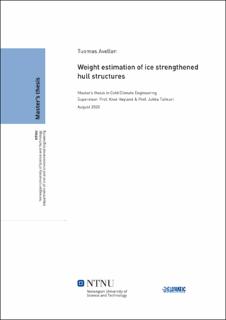| dc.description.abstract | The prevailing trend in ship design has been shifting towards holistic design process. This means that the different design aspects have all been incorporated together in order to find the design that is successful in all set criteria. For this reason, the different design aspects have to be simplified and divided into multiple subsystems that are in relations through dependencies and parameters. One particular parameter which has a lot of dependencies, is ship weight. Weight estimation and particularly its minimization has always been one of the most important tasks in ship design process.
This thesis work studies the effects of structural design selections on steel weight of ship’s ice strengthened hull structures. The research is conducted as a case study for a concept vessel designed to operate in first year ice conditions. Finnish-Swedish Ice Class Rules are chosen for this study. A design and optimization tool was developed in order to create different structural designs for the pre-defined hull form and to calculate their minimum weight. The tool creates desired structure topologies based on user’s commands and calculates the scantling requirements using the chosen ice class rules. Weight is calculated based on steel plate and profile selections. This selection is done using an optimization algorithm designed to solve constrained single-objective optimization problems with linear methods.
The tool calculated minimum weights for nine different structural designs with four different ice classes. Results indicated that the selected framing system has the biggest effect on weight. For the two greatest ice classes, frame spacing and ice stringer utilization also became moderately significant in terms of weight. The tool provides accurate and valuable weight data which can be used both in research and in the industry. This type of optimization and analysis could be used as a part of parametric ship design if it is developed further. | |
